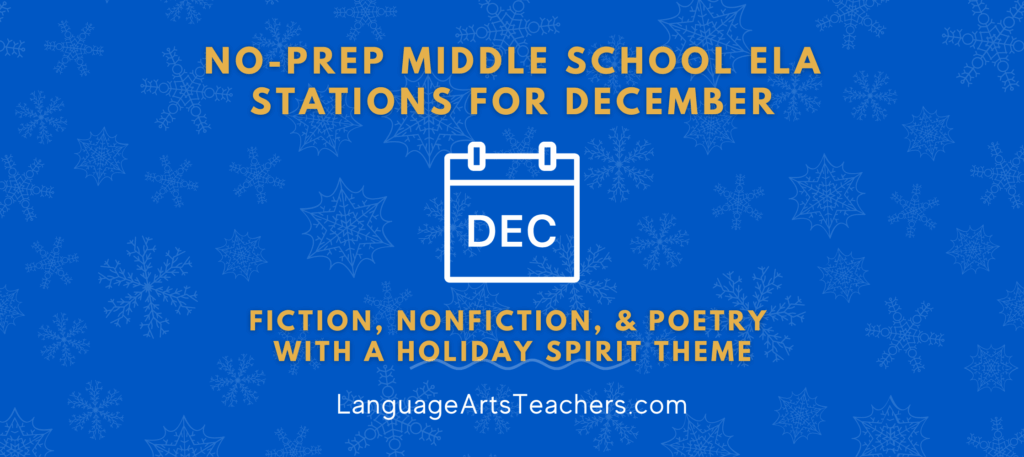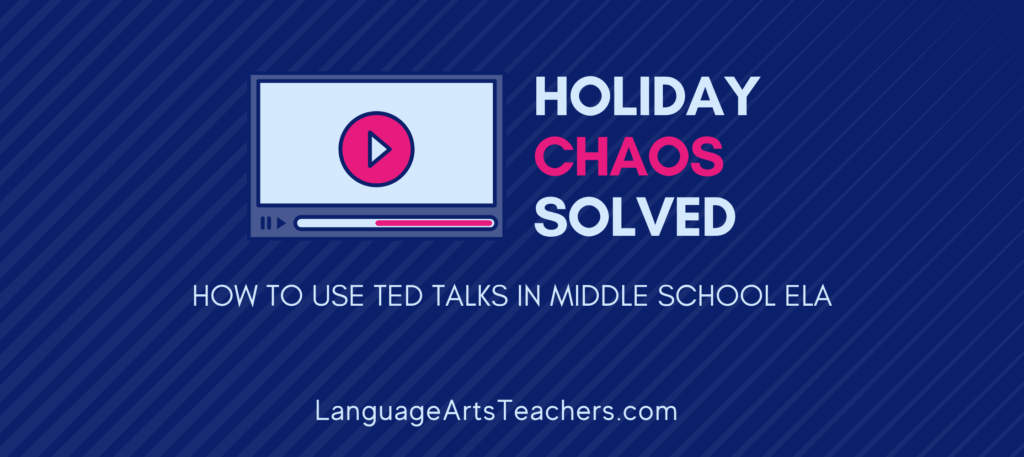The goal with implementing these four strategies for keeping students on task during group work is that each one serves to maintain student engagement. Each strategy is interesting for kids and allows for creative interactions between students to promote learning.
1) Use Music Strategically

While playing soft, instrumental music in the background can be a calming and useful way to manage a classroom, it won’t mean much after a while if it’s overused and becomes yet another “thing” in the room. So let’s use it carefully, strategically, and with intention.
Play the music for a specific amount of time or for a specific task, not just for the whole class period. For instance, if I want my students to work together reading a poem aloud several times at an acceptable volume, here’s how I use music to make it happen:
Say, “In your groups, take turns reading the poem aloud. I want you to assign each member a stanza to read and then keep reading it aloud again and again, going around the circle, until the music stops.”
Specific instructions like this accomplish two things:
First, there’s a reason now to keep the noise level down (rather than the vague mention about how “You’re too loud if we can’t hear the music anymore.”) Students won’t know whether or not to keep reading that poem unless they can hear when the music stops!
Second, this allows you as the teacher to decide exactly when you are ready to stop the music. As the music plays, you get to move from group to group, listening to the reading. You’re able to determine, right there in real time, how many times you want the kids to actually read the poem. Are they reading too quickly just to get it done? Are they stumbling over the words or structure so much that the meaning is lost? If so, stop the music to address the issue if it’s a problem with too many groups in the class; then hit the play button to continue.
How music helps with classroom management:
Playing the music like this is simply a way for me to keep students re-reading until I feel comfortable that they’re ready for the next step. With the music automated in the background of the class, students also won’t stop you every five seconds to ask if they need to keep going. The music takes care of that for you (but don’t overuse it or make them read the poem more than just a few times).
2) Special Timing of Read-Alouds

When students have to work collaboratively on an assignment, we can’t just expect them to work well for an endless amount of time. Young minds and energetic bodies are going to start wandering, and some days are more challenging than others, for sure!
Use a quick read-aloud to break up the time that kids are working together as a way to refocus the class and refresh the purpose of the group work.
But it can’t be just any read-aloud, though. It needs to fit with the topic of the assignment. For instance, if your students are working together to build a scale model of the Great Wall of China, you can’t just let them have an hour to do it. The focus won’t last. So segment the time by stopping part way through and bringing everyone together for a quick (5-10 minutes) read-aloud related to the group project.
Maybe it’s a Time for Kids article on the emperor who commissioned the building of the wall. Or perhaps it’s a recent online news story about the Great Wall of China Marathon race (yeah, that’s a real thing, but the race “only” covers 26.2 miles of the wall).
How Read-Alouds help with classroom management:
The point is that the read-aloud can be a quick way to get the students purposefully refocused on the task at hand. I especially like using the special timing of a read-aloud to begin a group work assignment that was started earlier but not finished, like before we went to an assembly or even a continuation of what we began yesterday.
3) The Magic of an Online Stopwatch

It’s exhausting and downright negative to go through the class each day muttering, “Come on! Hurry up! You only have six minutes left!”
So why bother? Let technology do it for you!
There are too many free online timers to count, but the one I find myself using each day is the basic, easy-to-use www.online-stopwatch.com. It’s consistent, reliable, and you can even choose any design from a simple countdown display to a ticking time bomb. My kids really like that one!
You can expand the timer to fit your entire computer screen and then turn the monitor so the kids can see the countdown more easily, or if you’re lucky enough to have a projector of some kind that places your screen front-and-center on a huge board in the room, use that.
Choose a specific amount of time for the task at hand that fits in with what you know about your kids. Each class you teach is different with its own dynamics. The time of day makes things work differently, too. Take those things into consideration, and then segment the group work into “time chunks.”
Time chunks refer to explaining one part of the group assignment that needs to be done first, and then setting the online stopwatch for the amount of time it should take.
For example, instead of making a vague statement that “Your group has the last 25 minutes of class to complete this activity” say, “Your group has 4 minutes to read the instructions and gather all necessary supplies.” At the end of the 4 minutes the timer will go off (don’t be alarmed if the kids start counting down the last 10 seconds and there’s a frenzy of activity), and you will again set the timer for the specific number of minutes necessary to complete the next task.
How an online timer helps with classroom management:
This is a realistic way to teach time-management skills. While the groups are working through each time segment, move around the room and check in with them. Instead of saying, “You’re down to eight minutes and you’ve hardly done anything!” say “Let’s see what you guys can accomplish in the eight minutes we have left!”
These statements are good ways to get students back on track and motivated to move forward, especially when the group activity is broken up into chunks using the timer. It keeps things from becoming overwhelming (for both you and your student groups).
4) Create a Non-Verbal Challenge

For this one, students will work together to complete a task in a quiet way with no talking or verbal sounds. I mean, they are going to do this silently! Here’s how I have used this very successfully in my own classroom.
We had spent parts of the last two class periods reading, annotating, and analyzing Jack Prelutzky’s poem, “The Witch”. (For specific details about how I teach my 6th grade students annotation skills, check out www.languageartsteachers.com/annotating). My students knew they were going to have a quiz over it the third day. Instead of just giving them the normal quiz questions on a handout, I copied each question ahead of time so that each one appeared in the largest font size possible per sheet of paper. I ended up with 11 questions on 11 pages of printer paper. I taped those 11 pieces of paper in the hallway a couple of feet apart from each other and we had a “silent collaborative quiz.”
The students saw the questions posted to the walls outside my classroom door as they were entering the room, but it didn’t matter. It only piqued their curiosity as to what in the world we were going to do.
Here’s what I said to my students:
“I have an a-MAZ-ing group challenge for you on today’s quiz. It’s a biggie! It’s called a NON-VERBAL challenge. It’s when you have to communicate and work together using nothing other than facial expressions, hand motions, and body movements. Does that make sense?”
By this point in your explanation, your voice can drop dramatically to a whisper.
“There’s no whispering, no speaking, no sounds at all! You can nod or shake your head. You can use facial expressions, arm or hand movements, gestures, etc.”
“It’s a CRAZY challenge for a quiz, but I know you guys can do it. You may answer the questions in any order, and you may also omit one so you’re only answering 10” (as a Language Arts teacher, I really thrive on even numbers that are easy to grade).
Then, using my own non-verbal strategies to communicate, I divided the kids into groups of 3-4 and gave each group a clipboard with a blank piece of notebook paper already on it for where they’d write the answers. Each group would only turn in one paper with the answers on it. The group members would simply take turns using the clipboard to write on. Each student had a clean copy of the poem we had been reading to refer to.
I then silently released the students to the hallway, and here’s what happened:
- Lots of movement as the kids scattered to read the questions
- Wild gesticulations that seemed random, but they really weren’t
- Jotting down words/phrases on scratch paper to convey meaning
- Quick sketches to get an idea across
- Banging and tapping sounds to get each others’ attention
- Scrunched-up looks of frustration
- The constant trading of clipboards as they took turns writing answers
How a non-verbal challenge helps with classroom management:
As each group finished, I had them sit down on the floor against the wall, totally silent. They started trading clipboards and comparing answers on their own while the others finished up. What better way to get them thinking and analyzing in a quiet, thoughtful way?
The kids were so much more focused on each others’ ideas and they spent more time communicating their thoughts (which translates to more time thinking about the questions, the poem, and how to respond).
This is probably the activity that should be repeated the least often of the four, but it sure is awesome to try! I only do this once in a while, like once a month, but it’s a powerful way to really be able to watch and listen and learn about your students.
The main takeaway from these four strategies for keeping students on task during group work is that each one serves to maintain student engagement. Each strategy is interesting for kids and allows for creative interactions between students to promote learning.



